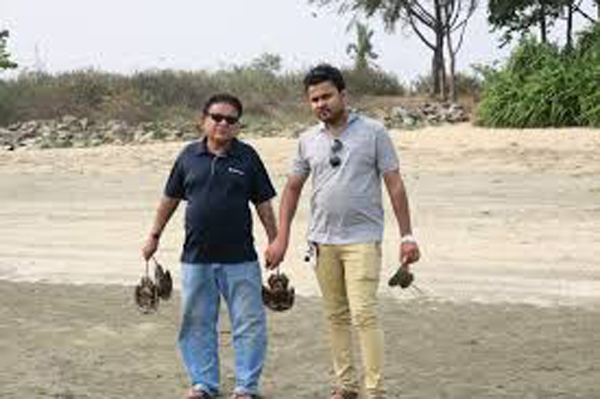Rashmi Rekha Das, OP
Siddhartha Pati, founder of the Association for Biodiversity Conservation and Research, has pioneered Horseshoe crab research in India
For much of human history, the phenomenal life beneath the ocean’s surface was a distant, unattainable world. Thanks to many curious and courageous individuals, however, marine science has grown into a vast and exciting field. While there are many who have contributed to save marine life, Siddhartha Pati stands out as an exceptional pioneer. Siddhartha, the founder of the Association for Biodiversity Conservation and Research (ABCR) has pioneered Horseshoe crab research in India. Recently, he was among three from Asia selected to receive the Future Conservationist Award given by the Conservation Leadership Programme (CLP) in UK. The annual award supports the work of early career conservationists for over 25 years. CLP is a partnership that includes the Wildlife Conservation Society, Fauna & Flora International, Bird Life International, and Conservation International. In an interview, Siddhartha expresses his concern about the dwindling number of Horseshoe crabs in Orissa, and on the Chandipur beach in particular.
Hailing from Balasore, Siddhartha grew up in a village near the Subarnarekha river known for its biodiversity. That is where he developed a passion for wildlife conservation. Siddhartha, who works as a research scholar in the department of bioscience and biotechnology at the Fakir Mohan University is also the investigator in a project for the conservation of the horseshoe crab supported by the Mohammed Bin Zayed Species Conservation Fund, Abu Dhabi, United Arab Emirates (UAE). His expertise lies in the area of restoration ecology and wildlife management, biodiversity conservation, and environmental ethics. Siddhartha has worked with WWF-India and the Malkolak Institute of Marine Studies, Goa, where he was able to combine his passion for history and hiking with his commitment to protect India’s wildlife.
Siddhartha says, “Apart from many prized species of flora and fauna, Orissa also has a living fossil to boast of. The Horseshoe crab, which is widely found along the coast of Chandipur, existed long before the arrival of dinosaurs. Two decades ago, Horseshoe crabs were found in large numbers along the coastal belt, but now the species is confined to specific pockets like Eakakula beach, Balarampur, the Chandipur beaches of Balasore district and Hukitola areas of Kendrapada district.”
He elaborates on the Horseshoe crab. “The Horseshoe crab is an amazing creature and considered to be the oldest living fossil in the world. It has descended from mud dwelling primitive arthropods, named trilobites, which lived in the Precambrian seas, nearly 600 million years ago. After 150 million years or so, the Horseshoe crab evolved into its present shape. While so many animals, including dinosaurs and many other latecomers to the Mesozoic era, are completely extinct, it is a wonder how the humble Horseshoe crab has survived for such a long period. It seems that this animal can overcome all kinds of adverse situations in its estuarine and coastal shallow habitat. It can also tolerate wide ranges of temperature, salinity, desiccation and submergence.”
Siddhartha explains how Horseshoe crabs are beneficial for human beings. “These crabs are prized for their blue blood, as it finds wide application in bio-medical sciences. The crab is in high demand worldwide for its therapeutic value. Its blood is used in making drugs for illnesses like mental exhaustion and gastroenteritis. Its blood cells can be extracted and crushed to provide a lysate – a chemical uniquely sensitive to bacterial toxins – that can be used to check for microbial contamination. However, most people here are unaware of these facts,” says the researcher. That apart, it is suspected that such crabs are being smuggled from the Bay of Bengal through Thailand and Malaysia.
Siddhartha adds: “Fishermen in India are ignorant of the commercial importance of the species and they generally throw Horseshoe crabs back into the sea when they are caught in the net while fishing. Additionally, the degradation of the crabs’ breeding grounds due to natural and anthropogenic activities has also resulted in mass depletion of the crab population along the coast. I would like to call for effective measures to protect these valuable breeding beaches along the coast. My project aims at implementing conservation measures to mitigate impacts on horseshoe crab populations along the coast and also focuses on raising conservation awareness among local stakeholders.”
Siddhartha, whose articles on Horseshoe crabs have been published in magazines like Science Reporter, Science Horizon, and Zoo Print Magazine, is also the recipient of many awards from organisations such as the World Wide Fund for Nature, India, Mohamed Bin Zayed Species Conservation Fund, UAE and Rufford Foundation, USA. That apart, he has also received the Biju Patnaik Award for Wildlife Conservation from the state government.
